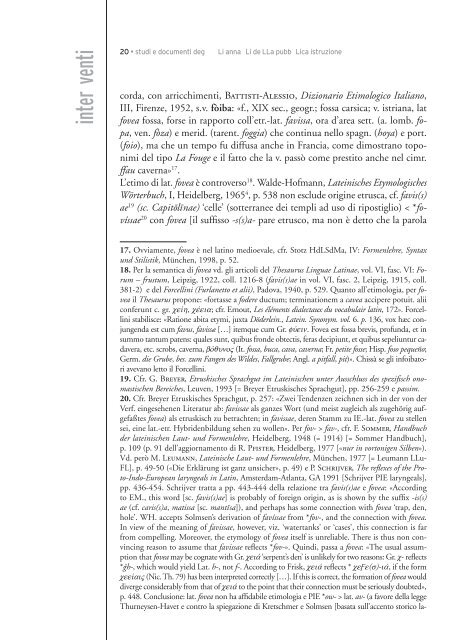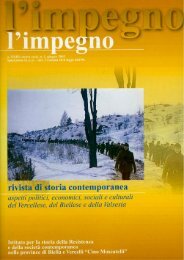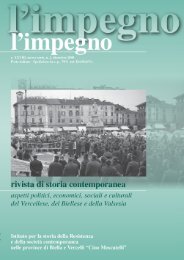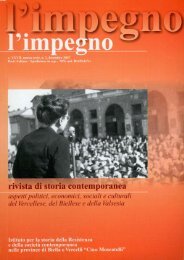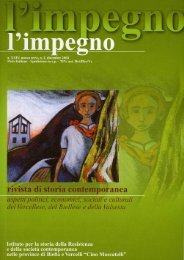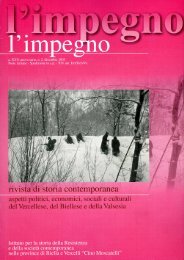Le vicende del confine orientale ed il mondo della scuola
Le vicende del confine orientale ed il mondo della scuola
Le vicende del confine orientale ed il mondo della scuola
You also want an ePaper? Increase the reach of your titles
YUMPU automatically turns print PDFs into web optimized ePapers that Google loves.
inter venti<br />
20 • studi e documenti deg Li anna Li de LLa pubb Lica istruzione<br />
corda, con arricchimenti, Battisti-Alessio, Dizionario Etimologico Italiano,<br />
III, Firenze, 1952, s.v. fòiba: «f., XIX sec., geogr.; fossa carsica; v. istriana, lat<br />
fovea fossa, forse in rapporto coll’etr.-lat. favissa, ora d’area sett. (a. lomb. fopa,<br />
ven. fòza) e merid. (tarent. foggia) che continua nello spagn. (hoya) e port.<br />
(foio), ma che un tempo fu diffusa anche in Francia, come dimostrano toponimi<br />
<strong>del</strong> tipo La Fouge e <strong>il</strong> fatto che la v. passò come prestito anche nel cimr.<br />
ffau caverna» 17 .<br />
L’etimo di lat. fovea è controverso 18 . Walde-Hofmann, Lateinisches Etymologisches<br />
Wörterbuch, I, Hei<strong>del</strong>berg, 1965 4 , p. 538 non esclude origine etrusca, cf. favis(s)<br />
ae 19 (sc. Capitōlīnae) ‘celle’ (sotterranee dei templi ad uso di ripostiglio) < *fovíssae<br />
20 con fovea [<strong>il</strong> suffisso -s(s)a- pare etrusco, ma non è detto che la parola<br />
17. Ovviamente, fovea è nel latino m<strong>ed</strong>ioevale, cfr. Stotz HdLSdMa, IV: Formenlehre, Syntax<br />
und St<strong>il</strong>istik, München, 1998, p. 52.<br />
18. Per la semantica di fovea vd. gli articoli <strong>del</strong> Thesaurus Linguae Latinae, vol. VI, fasc. VI: Forum<br />
– frustum, <strong>Le</strong>ipzig, 1922, coll. 1216-8 (favis(s)ae in vol. VI, fasc. 2, <strong>Le</strong>ipzig, 1915, coll.<br />
381-2) e <strong>del</strong> Forcellini (Furlanetto et alii), Padova, 1940, p. 529. Quanto all’etimologia, per fovea<br />
<strong>il</strong> Thesaurus propone: «fortasse a fodere ductum; terminationem a cavea accipere potuit. alii<br />
conferunt c. gr. ceivh, ceveia; cfr. Ernout, <strong>Le</strong>s éléments dialectaux du vocabulair latin, 172». Forcellini<br />
stab<strong>il</strong>isce: «Ratione abita etymi, juxta Döderlein., Latein. Synonym. vol. 6. p. 136, vox hæc conjungenda<br />
est cum favus, favissæ […] itemque cum Gr. fuvein. Fovea est fossa brevis, profunda, et in<br />
summo tantum patens: quales sunt, quibus fronde obtectis, feras decipiunt, et quibus sepeliuntur cadavera,<br />
etc. scrobs, caverna, bovquno" (It. fossa, buca, cava, caverna; Fr. petite fosse; Hisp. foso pequeño;<br />
Germ. die Grube, bes. zum Fangen des W<strong>il</strong>des, Fallgrube; Angl. a pitfall, pit)». Chissà se gli infoibatori<br />
avevano letto <strong>il</strong> Forcellini.<br />
19. Cfr. G. Breyer, Etruskisches Sprachgut im Lateinischen unter Ausschluss des spezifisch onomastischen<br />
Bereiches, <strong>Le</strong>uven, 1993 [= Breyer Etruskisches Sprachgut], pp. 256-259 e passim.<br />
20. Cfr. Breyer Etruskisches Sprachgut, p. 257: «Zwei Tendenzen zeichnen sich in der von der<br />
Verf. eingesehenen Literatur ab: favissae als ganzes Wort (und meist zugleich als zugehörig aufgefaßtes<br />
fovea) als etruskisch zu betrachten; in favissae, deren Stamm zu IE.-lat. fovea zu stellen<br />
sei, eine lat.-etr. Hybridenb<strong>il</strong>dung sehen zu wollen». Per fov- > fav-, cfr. F. Sommer, Handbuch<br />
der lateinischen Laut- und Formenlehre, Hei<strong>del</strong>berg, 1948 (= 1914) [= Sommer Handbuch],<br />
p. 109 (p. 91 <strong>del</strong>l’aggiornamento di R. Pfister, Hei<strong>del</strong>berg, 1977 [«nur in vortonigen S<strong>il</strong>ben»).<br />
Vd. però M. <strong>Le</strong>umann, Lateinische Laut- und Formenlehre, München, 1977 [= <strong>Le</strong>umann LLu-<br />
FL], p. 49-50 («Die Erklärung ist ganz unsicher», p. 49) e P. Schrijver, The reflexes of the Proto-Indo-European<br />
laryngeals in Latin, Amsterdam-Atlanta, GA 1991 [Schrijver PIE laryngeals],<br />
pp. 436-454. Schrijver tratta a pp. 443-444 <strong>del</strong>la relazione tra favis(s)ae e fovea: «According<br />
to EM., this word [sc. favis(s)ae] is probably of foreign origin, as is shown by the suffix -is(s)<br />
ae (cf. caris(s)a, matissa [sc. mantīsa]), and perhaps has some connection with fovea ‘trap, den,<br />
hole’. WH. accepts Solmsen’s derivation of favíssae from *fov-, and the connection with fovea.<br />
In view of the meaning of favissae, however, viz. ‘watertanks’ or ‘cases’, this connection is far<br />
from compelling. Moreover, the etymology of fovea itself is unreliable. There is thus non convincing<br />
reason to assume that favissae reflects *fov-». Quindi, passa a fovea: «The usual assumption<br />
that fovea may be cognate with Gr. ceiav ‘serpent’s den’ is unlikely for two reasons: Gr. c- reflects<br />
*gˆh-, which would yield Lat. h-, not f-. According to Frisk, ceiav reflects * ce¸e(s)-iav, if the form<br />
ceeivai" (Nic. Th. 79) has been interpret<strong>ed</strong> correctly […]. If this is correct, the formation of fovea would<br />
diverge considerably from that of ceiav to the point that their connection must be seriously doubt<strong>ed</strong>»,<br />
p. 448. Conclusione: lat. fovea non ha affidab<strong>il</strong>e etimologia e PIE *ow- > lat. av- (a favore <strong>del</strong>la legge<br />
Thurneysen-Havet e contro la spiegazione di Kretschmer e Solmsen [basata sull’accento storico la


